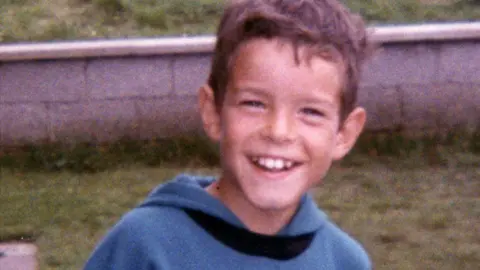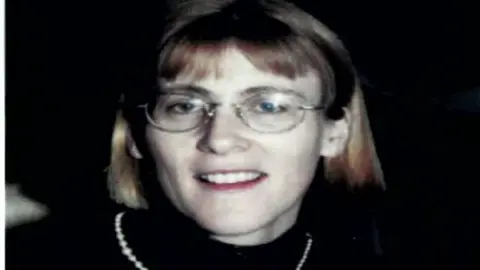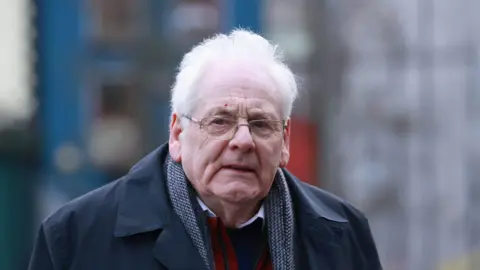Schoolboy 'personified hope' after 1998 peace deal
 McLaughlin family
McLaughlin familyThe family of a 12-year-old schoolboy killed in the Omagh bomb said he personified hope on the island of Ireland after the Good Friday Agreement.
Shaun McLaughlin was one of several schoolchildren killed in the bombing and had presented a poem to the then Irish president, Mary McAleese, just months before the attack in the County Tyrone town.
The Real IRA killed 29 people, including a woman who was pregnant with twins.
Shaun's poem to Ms McAleese, read: "Orange and green, it doesn't matter, united now won't shatter our dream."
The inquiry heard a statement from Shaun's mother Patricia, which was read by his aunt Marjory McDaid, and said the battle to find out what happened on the day of the bomb has been "relentless".
"None of the families deserved what happened that day," read the statement.
"I hope this inquiry will provide answers."
Shaun, from Buncrana, County Donegal, had been on a day trip to Omagh with his friends.
His mother's statement also told of how Shaun had been excited about going to Omagh.
He and his friends had stopped off in the town on the way home from a visit to the Ulster American Folk Park.
The inquiry was told that his father could only identify him from his watch.
The Omagh bomb, which exploded on 15 August 1998, resulted in the biggest death toll from any one single incident during the Troubles.
After years of campaigning by relatives, this inquiry was set to up examine if the bombing could have been prevented by UK authorities.
It resumed for its second week on Monday and is continuing to hear testimonies from more families who lost loved ones.
Bride-to-be 'cruelly robbed' of future, inquiry told
 Family photo
Family photoThe inquiry also heard a Sunday school teacher was on the "brink of a new life" when she was killed.
Esther Gibson, 36, was engaged to be married when she was fatally wounded.
Photos of her growing up were shown at the inquiry and a statement was read on behalf of her family.
The statement described Ms Gibson, who was shopping on the day of the attack, as a devoted Christian.
"She was a young woman with much to look forward to," her family said.
"Her faith was strong and she was preparing to embark on a new chapter of her life with her fiancé.
"Esther's murder cut short a life that was rich in kindness, love and promise."
Calls for 'parallel' Ireland inquiry
 PA
PAMeanwhile the father of one of victims of the bomb has said an "important discussion" on an inquiry in the Republic of Ireland should wait until after the current hearings.
Michael Gallagher told Good Morning Ulster that conversation should be parked until "we get these memorial hearings over".
It comes after former Irish government minister Charlie Flanagan said Ireland should have established its own parallel inquiry.
He said he was concerned vital evidence may not be seen by the Northern Ireland inquiry.
It cannot compel anyone from outside the UK to give evidence, such as current or former members of An Garda Siochána (Irish police).
The Irish government has promised to help and pledged that, if needed, it will pass legislation to address co-operation.
Sinn Féin leader Mary Lou McDonald said she agreed with Mr Flanagan as there was an issue over compelling people to give evidence.
Stormont Justice Minister Naomi Long told Good Morning Ulster she would be supportive of the Irish government "taking forward an inquiry".
However she had concerns that two parallel inquiries may mean people having to give evidence more than once and "may mean people having to be retraumatised".
What was the Omagh bomb?
The bomb exploded in Omagh town centre on a busy Saturday afternoon on 15 August 1998.
The attack took place four months after the signing of the 1998 Good Friday Agreement.
The RIRA - a dissident republican paramilitary group - disagreed with the Provisional IRA's decision to call a ceasefire ahead of the talks and continued to plant car bombs in towns across Northern Ireland.
But the Omagh bomb was by far the RIRA's most deadly attack.
In addition to the dead, more than 200 other people were wounded, some of whom survived with life-changing injuries.
Who carried out the Omagh bomb?
Three days after the 1998 attack, the Real IRA released a statement claiming responsibility for the explosion.
It apologised to "civilian" victims and said its targets had been commercial.
Almost 27 years on, no-one has been convicted of carrying out the murders by a criminal court.
In 2009, the judge in that case ruled four of the men - Michael McKevitt, Liam Campbell, Colm Murphy and Seamus Daly were all liable for the Omagh bomb.
The four men were ordered to pay a total of £1.6m in damages to the relatives, but appeals against the ruling delayed the compensation process.
A fifth man, Seamus McKenna, was acquitted in the civil action and later died in a roofing accident in 2013.
